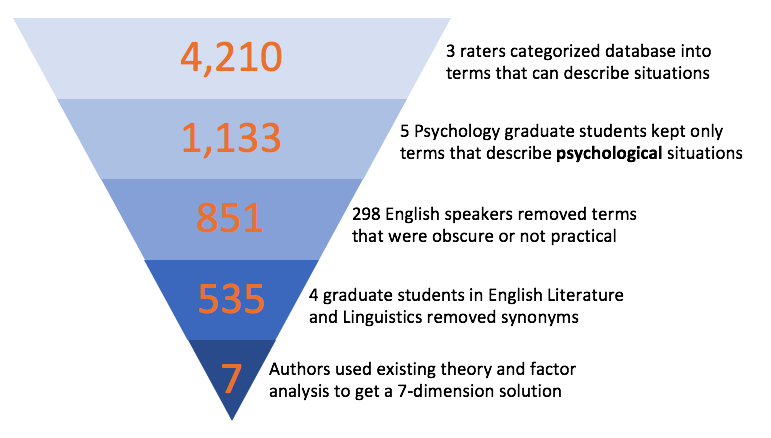A New Approach to Understanding Situations
-

The lexical approach is a language-based approach to developing taxonomies or organizing frameworks. The lexical approach stems from the lexical hypothesis, which states that any psychological concepts worth measuring should be relevant enough to humanity that it becomes embedded in human language as words or phrases. Therefore, the lexical approach is to take all terms used to describe a psychological concept (e.g., personality) and sort the terms into as few categories as possible, using both logic and statistical analyses. The resulting categories are then examined, labeled, and become the dimensions in the taxonomy, which essentially encompasses all aspects of the psychological concept. The lexical approach is more rigorous than other approaches for taxonomy development because it provides a thorough linguistic and empirical approach in addition to expert opinions.
Research in the field of psychology has advanced greatly due to the lexical approach, which was used to develop widely known and utilized personality taxonomies – the Big 5 and the HEXACO models. Though these taxonomies have greatly influenced our understanding of individuals, they focus only on terms used to describe people. The issue with this is that people do not exist in vacuums – people are heavily influenced by the situations they encounter. To address this gap in research, psychologists have recently used the lexical approach to develop a taxonomy of psychological situations (Parrigon, Woo, Tay, & Wang, 2017). The present article offers a summary of the development and structure of CAPTION – Parrigon et al.’s (2017) taxonomy of psychological situations. Following the description of CAPTION, I reflect on how this taxonomy impacts the field of Industrial-Organizational (IO) Psychology and propose future research and practical implications based on the CAPTION taxonomy.
Development & Structure of CAPTION
CAPTION is an acronym for the 7-dimensional model of psychological situations that Parrigon et al. (2017) derived across four lexically based studies. Specifically, the dimensions are: Complexity, Adversity, Positive valence, Typicality, Importance, Humor, and Negative valence. The CAPTION dimensions consistently emerged across a variety of samples and analytical methods.
The researchers who developed CAPTION started their endeavor by identifying descriptive situational terms used in subtitles of U.S. films from 1900-2007, as opposed to the dictionary, to ensure that the identified terms were actually used in modern language. From this database, Parrigon and colleagues used the process depicted in the figure below to develop the CAPTION taxonomy – the text on the right of the figure describes each step in the process and the numbers inside the figure depict the resulting number of adjectives after completing each step.
 To develop a usable taxonomy, Parrigon and colleagues used both qualitative (e.g., qualitative dimensional exploration) and quantitative methods (e.g., factor analysis), which consistently resulted in the 7 CAPTION dimensions. What this tells us is that all psychological situations, identified using the process described in the previous paragraph, can be described in terms of how complex, adverse, positive, typical, important, humorous, or negative they are. To make this taxonomy even more accessible to research and practice, Parrigon and colleagues even developed full- and short-form adjective-based measures that could be used to assess the psychological situation. Implication of CAPTION on the field of I/O Psychology The CAPTION taxonomy and measures have strong implications for both research and practice in the field of IO Psychology. Existing research has shown that CAPTION is a valid predictor of personality-relevant behaviors, emotions, need satisfaction, and motivation. CAPTION provides a foundation for examining the importance and relevance of psychological situations in the workplace.
To develop a usable taxonomy, Parrigon and colleagues used both qualitative (e.g., qualitative dimensional exploration) and quantitative methods (e.g., factor analysis), which consistently resulted in the 7 CAPTION dimensions. What this tells us is that all psychological situations, identified using the process described in the previous paragraph, can be described in terms of how complex, adverse, positive, typical, important, humorous, or negative they are. To make this taxonomy even more accessible to research and practice, Parrigon and colleagues even developed full- and short-form adjective-based measures that could be used to assess the psychological situation. Implication of CAPTION on the field of I/O Psychology The CAPTION taxonomy and measures have strong implications for both research and practice in the field of IO Psychology. Existing research has shown that CAPTION is a valid predictor of personality-relevant behaviors, emotions, need satisfaction, and motivation. CAPTION provides a foundation for examining the importance and relevance of psychological situations in the workplace. Though the field of IO Psychology has historically considered both individual differences and situational factors, there has almost always been a greater emphasis on the individual. Previous attempts have been made to address the importance of situations; however, CAPTION is unique in that it was developed using the same technique from which personality taxonomies were developed. This rigorous, lexical approach to psychological situations makes the statement that situations are just as much a part of humanity as personality.
Moving forward, the field of IO Psychology could benefit from using CAPTION to categorize workplace situations and understand the effects of situations on work behaviors and outcomes. Better yet, workplace behaviors and outcomes could be explained by examining the interactions between HEXACO personality traits and CAPTION situations. That is, the CAPTION taxonomy could be used to examine how different types of situations affect the relationship between personality and job performance. Therefore, CAPTION may also provide useful additional information to a job analysis by emphasizing the situational context in which work will be completed, which may affect the ideal personality traits for the job. Though it may be too early to claim major practical implications of CAPTION, there is potential for organizations to better understand their culture and climate and how these situational factors affect the workplace.
Though the field of IO Psychology has historically considered both individual differences and situational factors, there has almost always been a greater emphasis on the individual. Previous attempts have been made to address the importance of situations; however, CAPTION is unique in that it was developed using the same technique from which personality taxonomies were developed. This rigorous, lexical approach to psychological situations makes the statement that situations are just as much a part of humanity as personality.
Moving forward, the field of IO Psychology could benefit from using CAPTION to categorize workplace situations and understand the effects of situations on work behaviors and outcomes. Better yet, workplace behaviors and outcomes could be explained by examining the interactions between HEXACO personality traits and CAPTION situations. That is, the CAPTION taxonomy could be used to examine how different types of situations affect the relationship between personality and job performance. Therefore, CAPTION may also provide useful additional information to a job analysis by emphasizing the situational context in which work will be completed, which may affect the ideal personality traits for the job. Though it may be too early to claim major practical implications of CAPTION, there is potential for organizations to better understand their culture and climate and how these situational factors affect the workplace.